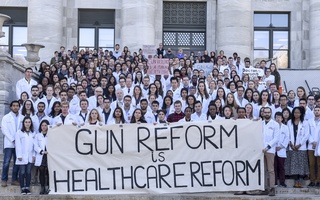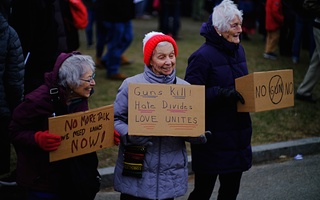About two months ago, my father drove my mother to the gun range. She’s a security guard for an elementary school in our town, and after the deadly shooting at Marjory Stoneman High School in Parkland, Fla., the hallways had become tense. A coffee-stained rumor from the teacher’s lounge has it that the district’s Board of Education might mandate security start carrying weapons.
She decided that, to be as prepared and knowledgeable of this potential work requirement as possible, she should learn to handle a gun. My mother, affectionately called “Miss Maria” by doting fifth graders who give her hand-written cards and friendship bracelets, thought she needed to learn what the recoil of a Colt 1911 felt like to keep her students safe.
This should never have happened.
Last month, cities erupted in protests. March for Our Lives, pioneered by Parkland survivors and today’s youth, took the country by the throat. To make sure that tragedies like Columbine, like Newtown, like Parkland, and like dozens of others don’t happen again, protesters called for public officials to heed their voices and their stories to pass stricter gun-control laws. Already we’ve seen that these protests have had tangible effects in government: Florida Governor Rick Scott signed off on multiple different gun laws such as raising the minimum age of purchase to 21, increasing purchasing restrictions, funding mental health services and police officers for schools, and allowing school staff such as librarians, counselors, and coaches to carry weapons. Save the last point, these are steps in the right direction to putting an end to these tragic schools shootings.
Yet, perhaps these preventative measures and these protests aren’t big enough. Or maybe—more aptly—they’re too big.
Don’t get me wrong; large scale change is not only great, but necessary. To enact lasting institutional change, we must start at the national level and alter the foundation on which states and public schools operate to have a widespread and standardized effect. However, waiting for this legal process to run its course through the federal system takes time. While change pitter-patters and trickles its way down to local governance, schools are left to their own devices to determine what approaches are best to protect their students, and students are left to determine how best to capture national movements in their own hallways. When this happens, treatment of the gun violence problem in schools can become inconsistent and leave room for mistakes to be made.
For instance, one school district decided that equipping classrooms with buckets of rocks to fend off possible school shooters was the best move. To many more, treating the problem of gun violence translates to hiring more security and thrusting upon them the sudden responsibility of handling firearms without the proper hundreds of hours of training that even the military requires of its soldiers, nonetheless mundane civilians taking care of kids (like my mother).
Students trying to galvanize action in their local communities participated in the National School Walkout Day; many, including those in my hometown, also took their concerns to local town halls to affect change. Even at Harvard, students take it into their own hands to implement local change. They organize Institute of Politics events to discuss gun control, protest on the streets, and demand that Harvard make its stance on these protests clear for future students and increase its gun violence research. Though these are all admirable actions, it is not enough for students to address the issue sporadically and on their own accord; it places an unreasonably high burden on the shoulders of young people to do everything themselves. There needs to be more guidance and participation in local governance to enact and make change tangible in everyday life.
If communities took initiative to implement effective preventative measures on a local level, this would have a higher chance of affecting real change for school and college students. This would allow for efforts to be initiated and standardized more swiftly than if they were left purely to the national level. It could also incentivize more dialogue and conversation that could even help communities to find alternatives to giving their staff guns (because although Trump thinks security guards don’t love their students if they don’t carry guns, having a firearm actually increases the risk for violence). This is especially important in school districts like mine where most students come from minority backgrounds: On average, Hispanic or Latinx students are twice, and black students three times as likely to experience gun violence at school.
Security guards like my mother and students like those in my hometown, though, are not unique; all over the country, there are regular people willing to go into immediate and immense lengths to enact visible change in their communities. We need to harness the emotion and the fervor fanning these protests, these movements, and these larger legislative changes to ensure that they are being adequately and appropriately implemented on the local level so that tragedies like Parkland never happen again. Without smaller community changes first, ensuring student safety becomes much more difficult.
Jessenia N. Class ’20, a Crimson Associate Editorial Editor, is a Cognitive Neuroscience and Evolutionary Psychology concentrator in Quincy House.
Read more in Opinion
Against Stifling Professional Service

















